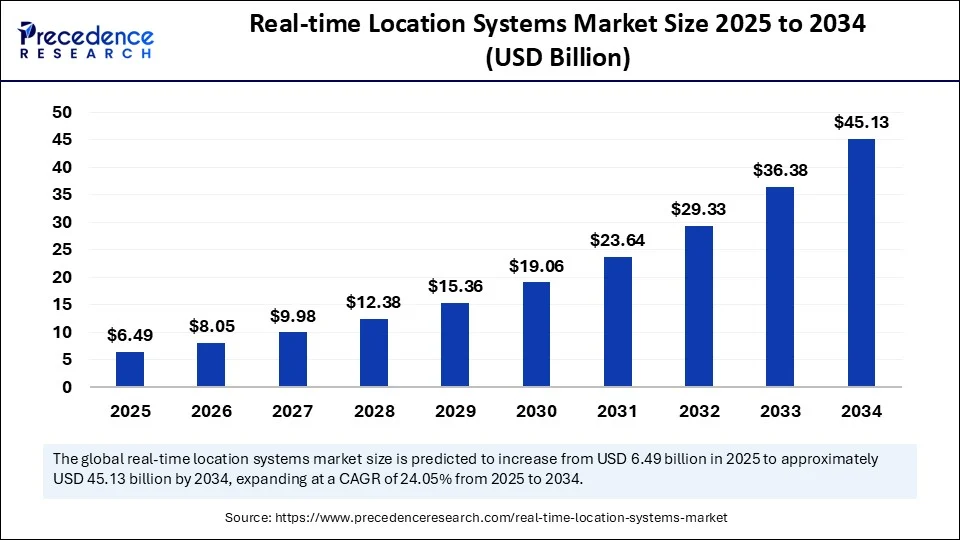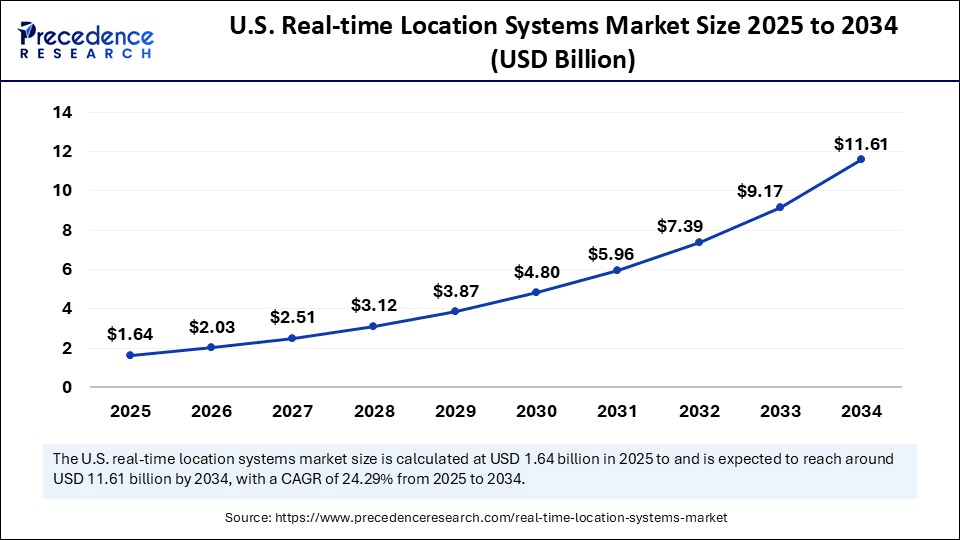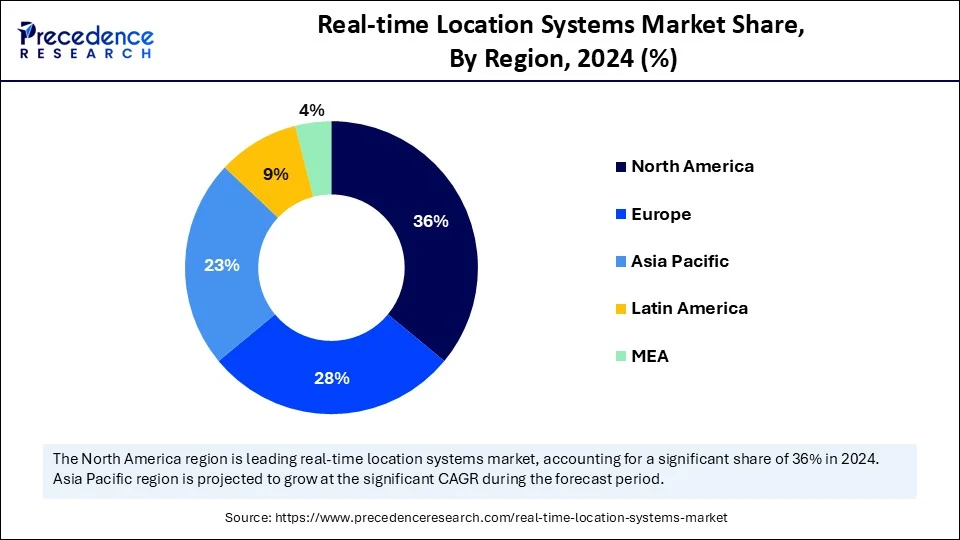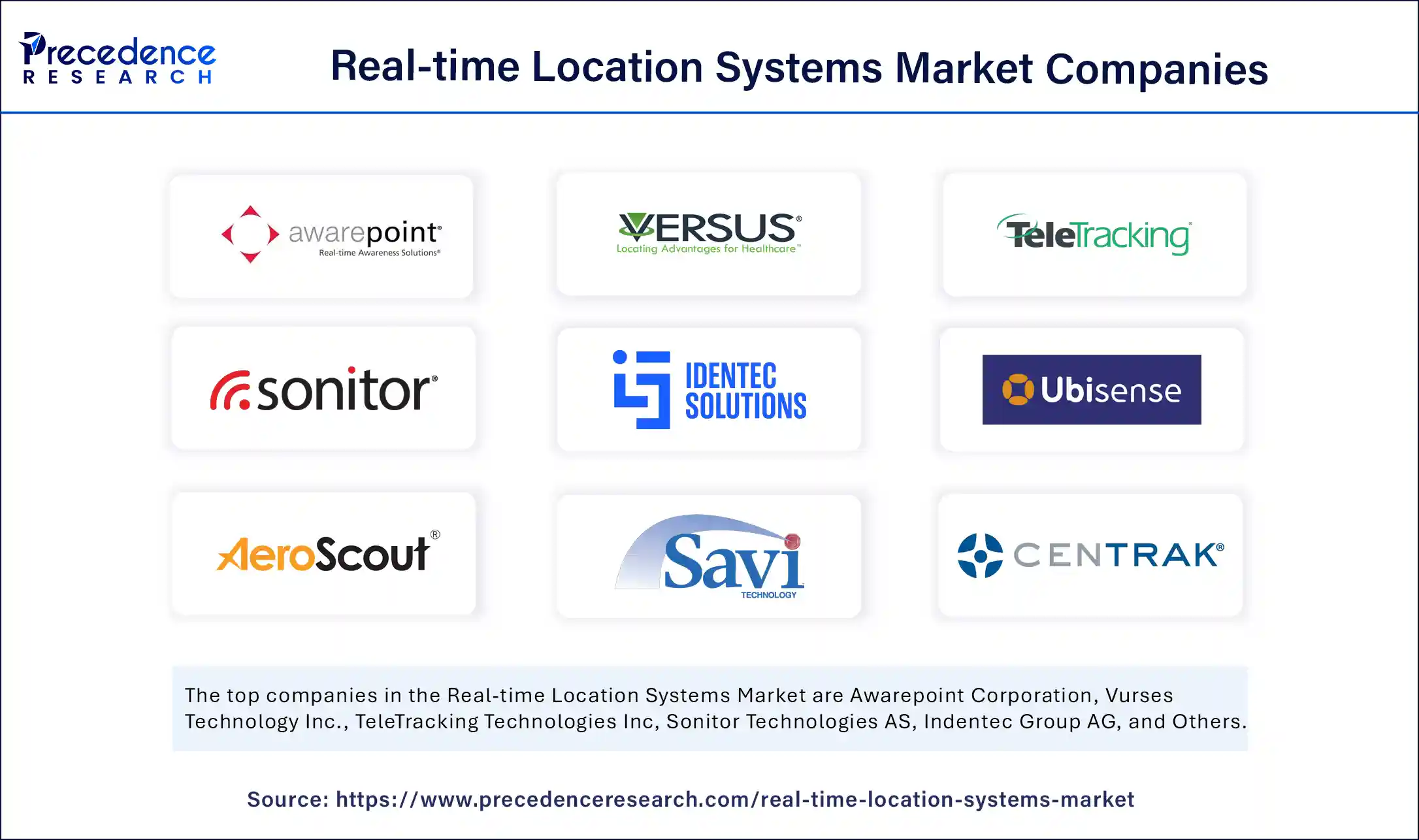List of Contents
Real-time Location Systems Market Size and Forecast 2025 to 2034
The global real-time location systems market size was calculated at USD 5.23 billion in 2024 and is predicted to increase from USD 6.49 billion in 2025 to approximately USD 45.13 billion by 2034, expanding at a CAGR of 24.05% from 2025 to 2034. The market is driven by rapid urbanization, rising need for advanced security systems, rising use of smartphones and mobile gaming, and rapid growth in adoption in the healthcare segment.

Real-time Location Systems Market Key Takeaways
- In terms of revenue, the global real-time location systems market was valued at USD 5.23 billion in 2024.
- It is projected to reach USD 45.13 billion by 2034.
- The market is expected to grow at a CAGR of 24.05% from 2025 to 2034.
- North America dominated the global real-time location systems market with the largest market share of 36% in 2024.
- Asia Pacific is anticipated to grow at the fastest CAGR during the forecast period.
- By technology type, the RFID segment hele the biggest market share in 2024.
- By technology type, the UWB (Ultra-Wideband) segment is expected to grow at the fastest CAGR during the forecast period.
- By component, the hardware segment accounted for a considerable share in 2024.
- By component, the software (AI-driven analytics and integration) segment is projected to experience the highest growth CAGR between 2025 and 2034.
- By application, the inventory/asset tracking segment led the market in 2024.
- By application, the personnel/ staff tracking segment is set to experience the fastest CAGR from 2025 to 2034.
- By industry, the healthcare segment generated the major market share in 2024.
- By industry, the logistics & transportation segment is anticipated to grow with the highest CAGR during the studied years.
How Artificial Intelligence (AI) Transforming the Real-time Location Systems Market?
Using artificial intelligence (AI) with real-time location systems (RTLS) aids decision making by creating maintenance schedules, that predict equipment issues before they arise. This reduces emergency repairs and helps smooth overall operations. AI's biggest strength is its versatility. It can enhance efficiency, automate routine work, and uncover insights in almost any industry. From speeding up medical diagnoses to helping businesses work smarter, AI transform how we live and work. Our smartphone uses AI, as do services like social media websites, chatbots, digital assistance, and much more.
AI uses high datasets from previous data movements to predict congestion and slowdowns. GPS system equipped with AI can anticipate peak traffic hours and suggest alternative schedules for fleets and reducing time spent in transit. AI is also used to develop self-driving cars and improve traffic management.
U.S. Real-time Location Systems Market Size and Growth 2025 to 2034
The U.S. real-time location systems market size was evaluated at USD 1.32 billion in 2024 and is projected to be worth around USD 11.61 billion by 2034, growing at a CAGR of 24.29% from 2025 to 2034.

North America dominated the global real-time location systems market in 2024. The need for process optimization & cost reduction, rising demand for RTLS in healthcare segment, and recent advancements in fleet tracking driving the growth of the market in North American region. In particular, the healthcare sector has become a major driver, utilizing RTLS to track medical assets, enhance patient safety, manage staff workflows, and support infection control protocols. Additionally, the rapid growth of e-commerce in the region has pushed logistics providers and warehouses to adopt real-time tracking for better inventory and supply chain management.

Asia Pacific is anticipated to grow at the fastest rate in the market during the forecast period. Regulatory compliance, operational efficiency in manufacturing, demand for improved patient safety and workflow efficiency, increasing adoption of IoT and smart technologies, and increasing need for asset/inventory tracking contributing the growth of the real-time location systems market in the Asia Pacific region. This explosive growth is driven by rapid industrialization, smart manufacturing initiatives, and government-led digital infrastructure programs in key countries such as China, India, Japan, and South Korea. These nations are increasingly adopting RTLS to support Industry 4.0, streamline supply chains, and improve asset visibility in large-scale operations.
Market Overview
Real-time location system is also called real time tracking systems, are used to automatically identify and track the location of objects or people in real time, generally within a building or other contained area. Real time location system (RTLS) in healthcare are used to provide immediate or real time tracking and management of medical equipment, staff, and patients within all types of patient care environments. The primary use-case for an RTLS is to provide better visibility of company assets. These assets include carts, containers, work orders, materials, vehicles, equipment, personnel, and so much more.
The real-time location systems market growth is driven by rapid urbanization, increasing use of smartphones and mobile gaming, rising need for advanced security systems, recent advancements in fleet tracking, advancement in tracking technology, rapid growth in adoption in the healthcare segment, and need for cost reduction and process optimization.
What Factors Are Fueling the Rapid Expansion of the Real-time Location Systems Market?
- Regulatory compliance: The benefits of regulatory compliance in real-time location system include increasing profitability, reducing risk, gaining better branding, fostering healthy competition, increasing safety and efficiency in the workplace, and avoiding unnecessary legal issues. It also includes a benefit like improving employee satisfaction and retention, increasing operational efficiency, reducing legal and financial risks, and boosting company reputation and trust. Regulatory compliance helps ensure that companies do not engage in unethical or illegal practices, and can be used to protect their employees and customers, may by protecting their data, namely personally identifiable information and protected health information.
- Operational efficiency in manufacturing: Real-time location systems (RTLS) allow manufacturers to track the real time location of critical assets like equipment, tools, and machinery. This ensures that assets are available when needed, mitigating downtime, and enhancing overall equipment utilization. RTLS improve manufacturing operations by providing real-time tracking and data integration in order to improve asset utilization, inventory management, production efficiency, safety, and decision-making.
- Increasing adoption of IoT and smart technologies: IoT and smart technologies improve logistics with real-time tracking, enhancing supply chain visibility, and efficiency. IoT sensors attach to shipments, vehicles, or warehouse assets, and provide real time updates on condition monitoring like vibration or tilt sensor detect damage or mishandling, temperature ensuring perishable goods stay within safe limits, and location GPS allowed trackers offer accurate positioning.
Market Scope
| Report Coverage | Details |
| Market Size by 2034 | USD 45.13 Billion |
| Market Size in 2025 | USD 6.49 Billion |
| Market Size in 2024 | USD 5.23 Billion |
| Market Growth Rate from 2025 to 2034 | CAGR of 24.05% |
| Dominating Region | North America |
| Fastest Growing Region | Asia Pacific |
| Base Year | 2024 |
| Forecast Period | 2025 to 2034 |
| Segments Covered | Technology, Component, Application, Industry Vertical, and Region |
| Regions Covered | North America, Europe, Asia-Pacific, Latin America, and Middle East & Africa |
Market Dynamics
Drivers
Rapid growth in adoption in the healthcare segment
Realt time location system in healthcare is used to provide immediate or real-time tracking and management of medical equipment, staff, and patients within all types of patient care environments. Real time patient monitoring systems include the use of advanced medical devices that allow continuous observation and analysis of patient's health data. It differs from patient monitoring of the past by providing immediate care solutions the moment an anomaly is detected.
Restraint
Privacy and security concerns
Location tracking is becoming a vital privacy concern, as it is increasingly used in software applications in our personal lives and work. GPS refers to a satellite-based navigation system that supplies information about locations and time on Earth. It is increasingly vulnerable to intentional attacks and other disturbances, generally due to its historic dependence on weak, unencrypted signals beamed from space. GPS tracking devices concerns include personal, consumer, and employee privacy by collecting and sharing location data without consent.
Opportunity
Smart infrastructure development
Real-time location systems (RTLS) are modernizing smart cities by providing accurate and timely location information for people and assets, how RTLS can allow new applications and benefits for smart city stakeholders. RTLS technology allows businesses to gain better oversight of where assets are in real time over the course of that asset's life. Real time location system integration helps organizations to monitor or orchestrate robots, smart infrastructure, manual machines, and items like pallets or carts in real time. RTLS needs planning and infrastructure to sync tag, networks, sensors, to provide robust workflows, security, inventory tracking, and more.
Technology Type Insights
The RFID segment held a dominant presence in the real-time location systems market in 2024. Real-time location system (RTLS) helps us to achieve and maintain 99.9% inventory accuracy without the laborious and may expensively inventory audits that can take hours or sometimes days. An RFID chips sends ratio signals to reader every few seconds, while an RTLS tag operates on Bluetooth or WiFi capabilities. One of the most important features of the RFID is that it can be used for real-time tracking of assets. This feature allows for near real-time monitoring and reporting of the location, movement, and status of assets, which can be significant value for many businesses.
The UWB (Ultra-Wideband) segment is expected to grow at the fastest rate in the market during the forecast period of 2025 to 2034. Real-time location system (RTLS) on UWB (ultra-wideband) technology helps organizations to be more productive, cost effective, and more. UWB based RTLS technology uses radio waves signals as the basis to calculate the position of assets. The benefits of UWB include high positioning accuracy, high security, good multipath resistance, low power consumption, and strong penetration.
Component Insights
The hardware segment accounted for a considerable share of the real-time location systems market in 2024. Real-time location system (RTLS) is transforming the way businesses track assets, manage inventory, and improve operational efficiency. Hardware benefits include reduce costs by automating routine tasks like payroll, accounting, and record keeping. It also helps to increase business efficiency & staff productivity, develop more effective communication within the business or with customers, and improve customer service or supplier relationships.
The software (AI-driven analytics and integration) segment is projected to experience the highest growth rate in the market between 2025 and 2034. The benefits of software include no imposed upgrades, better planning, cost reduction, customer satisfaction, cost effectiveness, tailored functionality, sales lead, ownership, leveraging technology, system integration, data security, communication, simplified decision making, and more.
Application Insights
The inventory/asset tracking segment led the real-time location systems market. Asset tracking also helps organizations with compliance, maintenance schedules, and overall cost control. It is essential for business looking to improve their operations and maximize their return on investment. Asset tracking is used across various industry for many applications like supply chain management. Inventory management benefits include improved cash flow through reduced losses, optimization of storage needs, and reduced inventory costs.
The personnel/ staff tracking segment is set to experience the fastest rate of market growth from 2025 to 2034. The benefits of monitoring staff performance include increased productivity, enhanced adherence to company policies, and enhanced data security. Monitoring can help identify areas for improvement, provide valuable insights for performance evolutions, and ensure that employees are meeting expectations.
Industry Insights
The healthcare segment registered its dominance over the market in 2024. The benefits of real-time location system (RTLS) in healthcare include streamlined staff workflow, improved patient safety and monitoring, and improved asset tracking and utilization. By tracking patients and assets in real-time, RTLS can reduce medical errors and improve patient safety. RTLS can improve hospital workflows, increase equipment use, simplify patient monitoring, and reduce documentation errors.
The logistics & transportation segment is anticipated to grow with the highest CAGR in the market during the studied years. Real time tracking is important in transportation management for route optimization and traffic management. Real time location system (RTLS) allows logistics companies to improve their route, avoiding traffic congestions, and taking the most efficient paths available.
Real-time Location Systems Market Companies

- Awarepoint Corporation
- Vurses Technology Inc
- TeleTracking Technologies Inc
- Sonitor Technologies AS
- Indentec Group AG
- Ubisense Group PLC
- AeroScoute (Stanley Healthcare)
- Savi Technology
- CenTrack Inc
- Zebra Technologies Corporation
- Honeywell International Inc
- Stanley Black & Decker Inc
Recent Developments
- In March 2025, an attendance system which uses photographs with real time location details embedded in them was introduced by the Primary Education Department, Gorakhaland Territorial Administration (GTA). (Source: https://www.millenniumpost.in)
- In December 2024, AirFinder OnSite, a next generation IoT asset tracking platform for campus-based environments that dramatically improves accuracy and affordability was announced by Link labs, a leading provider of an end-to end IoT platform for locating, managing, and monitoring equipment, supplies, and assets anywhere at any time. (Source: https://www.iotforall.com)
Segment Covered in the Report
By Technology
- RFID
- Wi-Fi
- BLE (Bluetooth Low Energy)
- Infra-red (IR)
- Ultrasound
- UWB (Ultra-Wideband)
- GPS
- Zigbee
- Others
By Component
- Hardware (tags, readers, sensors, gateways)
- Software
- Services
By Application
- Inventory/Asset Tracking
- Personnel/Staff Tracking
- Access Control & Security
- Workflow/Process Automation
- Fleet Tracking
- Environmental Monitoring
- Others
By Industry Vertical
- Healthcare
- Manufacturing
- Logistics & Transportation
- Retail
- Oil & Gas
- Defense
- Education
- Government
- Others
By Region
- North America
- Europe
- Asia Pacific
- Latin America
- Middle East & Africa
For inquiries regarding discounts, bulk purchases, or customization requests, please contact us at sales@precedenceresearch.com
Frequently Asked Questions
Ask For Sample
No cookie-cutter, only authentic analysis – take the 1st step to become a Precedence Research client